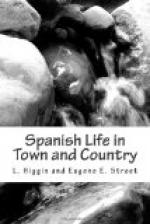It is the fashion to-day to minimise the influence of the Goths on the national characteristics of the Spaniard. We are told by some modern writers that their very existence is little more than a myth, and that the name of their last King, Roderick, is all that is really known about them. The castle of Wamba, or at least the hill on which it stood, is still pointed out to the visitor in Toledo, perched high above the red torrent of the rushing Tagus; but little seems to be certainly known of this hardy Northern race which, for some three hundred years, occupied the country after the Romans had withdrawn their protecting legions. On the approach of the all-conquering Moor, many of the inhabitants of Spain took refuge in the inaccessible mountains of the north, and were the ancestors of that invincible people known in Spain as “los Montaneses,” from whom almost all that is best in literature, as well as in business capacity, has sprung in later years.
How much of the Celt-Iberian, or original inhabitant of the Peninsula, and how much of Gothic or of Teuton blood runs in the veins of the people of the mountains, it is more than difficult now to determine. It had been impossible, despite laws and penalties, to prevent the intermingling of the races: all that we certainly know is that the inhabitants of Galicia, Asturias, Viscaya, Navarro, and Aragon have always exhibited the characteristics of a hardy, fighting, pushing race, as distinguished from the Andaluces, the Valencianos, the Murcianos, and people of Granada, in whom the languid blood of a Southern people and the more marked trace of Arabic heritage are apparent.
The Catalans would appear, again, to be descendants of the old Provencals, at one time settled on both sides of the Pyrenees, though forming, at that time, part of Spain. Their language is almost pure Provencal, and they differ, as history shows in a hundred ways, from the inhabitants of the rest of Spain. The Castilians, occupying the centre of the country, are what we know as “Spaniards,” and may be taken to hold a middle place among these widely differing nationalities, modified by their contact with all. Their language is that of cultivated Spain. No one dreams of asking if you speak Spanish; it is always: Habla v Castellano? And it is certainly a remnant of the old Roman, which, as we know, its emperors spoke “with a difference,” albeit there are many traces of Arabic about it.
Even at the present day, when Spain is rapidly becoming homogeneous, the people of the different provinces are almost as well known by their trades as by their special characteristics. A Gallego—really a native of Galicia—means, in the common parlance, a porter, a water-carrier, almost a beast of burden, and the Galicians are as well known for this purpose in Portugal as in Spain, great numbers finding ready employment in the former country, where manual labour is looked upon as impossible for a native.




